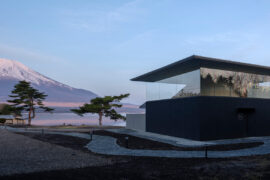How can companies avoid being blindsided by new technologies? Hervé Coureil of Schneider Electric shares some tips on how to spot challenges that often begin as weak signals at the periphery.

October 3rd, 2018
We knew who they were — and they knew us. I am speaking of our competitors; that is, the ones before we embarked on our digital journey. Indeed, before digital disruption started to take hold a decade ago, executives kept a sharp eye on their company’s close competitors.
That meant regularly checking market performance and reading the latest trade write-ups of solution offerings and advancements. Back then, our shared competitive landscape was a known roadmap with clear markers, common trends, and consistent R&D efforts to stay ahead of the curve.
Now, as all companies often face new technologies, demographic shifts, new rivals, new regulations, and other environmental changes that seem to come from nowhere, how can we avoid being blindsided?And, moreover, how can we capitalise on these changes?
The challenges faced often begin as weak signals at the periphery: the blurry zone at the edge of an organisation’s vision. As with any peripheral vision, these signals are difficult to see and interpret, but they can be vital to success or survival.
Today, as industry incumbents, we all must widen our view, allowing for a ‘healthy paranoia’ of what’s happening in other industries. Now, it’s about waking up every morning and looking beyond obvious competitors, as well as scrutinising what’s happening on the fringes of one’s ‘business as usual’.
Are new entrants unbundling legacy monolithic business models into new digital service offers built to address customer needs quickly? Are new ways of solving customer problems responsively powered by — or built around — technology such as voice, vision, mobile, AR, etc?
We know how it goes: to a hammer, all problems look like a nail.
Likewise, new digital technologies allow us to both envision existing problems through a new lens and to see solutions that never were envisioned before.

And, as Harvard Business School professor Clayton Christensen stated almost 15 years ago when he formulated the Law of Conservation of Attractive Profits in his book The Innovator’s Solution, “When attractive profits disappear at one stage in the value chain because a product becomes modular and commoditised, the opportunity to earn attractive profits with proprietary products will usually emerge at an adjacent stage.”
Most companies are proficient at tracking developments in existing technologies that could affect their business. But this focus can deflect attention from emerging technologies and lateral disruptors’ and incumbents’ movements that could be important in the future. This approach has been a fundamental driver for Schneider Electric’s digital transformation innovation.
It’s also a way to wrest ourselves from the complacency that success often brings. Our commitment to customer-centric innovation drives us every day. So, indeed, we must be open to some level of healthy paranoia to continually pay attention well beyond our industry at what potentially may change the competitive landscape — even at a moment’s notice.
Our IoT-enabled architecture EcoStruxure™ is the lens through which we see — and bring about — the digital future.
Technology flattens everything. What’s happening in another industry may end up having a strong impact on your own company after a while. An expanded ecosystem of digital players is key to being able to act fast. Ecosystem partners can bring a higher level of agility and a much broader base of technology expertise than any one player, they can act as a virtual network of sensors enabling the early detection of disruption weak signals in adjacent industries.
Combined with decades of domain expertise from a company such as Schneider Electric, a thriving ecosystem sets you on a stable path for successfully navigating today’s accelerated digital economy.
For Schneider Electric, leading the digital transformation of energy management and automation is not just about energy. We also need to move information together with energy. And that’s really where the world of energy and the world of information technology are blending together thanks to widespread connectivity and IoT.
What’s more, this digital world of energy is not just about digitising. It’s also about becoming digital. That’s the dynamic duo — digitising and going digital — that has been so well described by Jeanne Ross of MIT. Offering a frictionless customer experience requires one to become Digital and to Digitise at the same time.
Let’s not overlook the fact that such an ecosystem inherently thrives on a mindset of empowerment. That’s very key, especially in the digital world. You need to be genuinely looking at empowering others, whether employees, customers, partners, associates, and or technology partners, to respond innovatively in order to solve current customer problems.
This mindset inspires the whole organisation and its ecosystem to push hard beyond traditional, clear industry boundaries to seize the reward of developing relevant solutions that improve efficiency, productivity, safety, and sustainability. Really, solutions that make the world a better place. As Bill Gates famously said: “As we look ahead […], leaders will be those who empower others.”
What may come as a surprise – when we scan the periphery of digital disruption – is that healthy paranoia and empowerment are actually complementary — not contradictory.
INDESIGN is on instagram
Follow @indesignlive
A searchable and comprehensive guide for specifying leading products and their suppliers
Keep up to date with the latest and greatest from our industry BFF's!

For Aidan Mawhinney, the secret ingredient to Living Edge’s success “comes down to people, product and place.” As the brand celebrates a significant 25-year milestone, it’s that commitment to authentic, sustainable design – and the people behind it all – that continues to anchor its legacy.

The undeniable thread connecting Herman Miller and Knoll’s design legacies across the decades now finds its profound physical embodiment at MillerKnoll’s new Design Yard Archives.

Schneider Electric’s new range are making bulky outlets a thing of the past with the new UNICA X collection.

In this comment piece by Lin (Leo) Meng, computational design lead at HDR, we hear about the interface of data and design.
The internet never sleeps! Here's the stuff you might have missed

With prime views over Japan’s Mount Fuji, Yū Momoeda’s sauna facility defies typical standards to respond to the undulations of nature.

Karndean’s newly evolved Opus range brings versatility and durability to the forefront of commercial flooring. Blending design-led aesthetics with robust, high-performance functionality, it’s a go-to solution for spaces that demand both style and resilience.